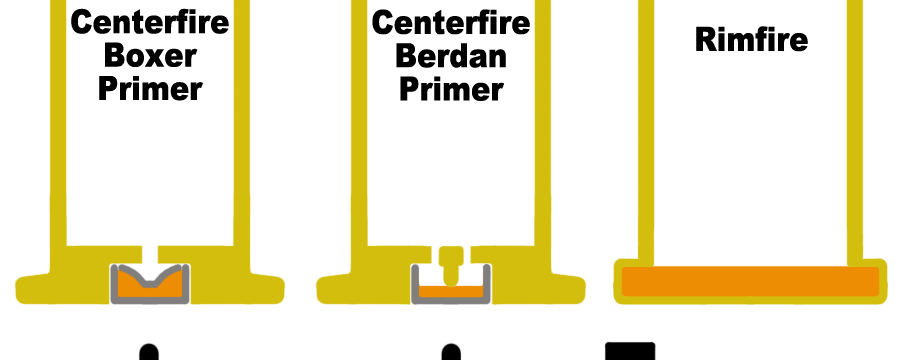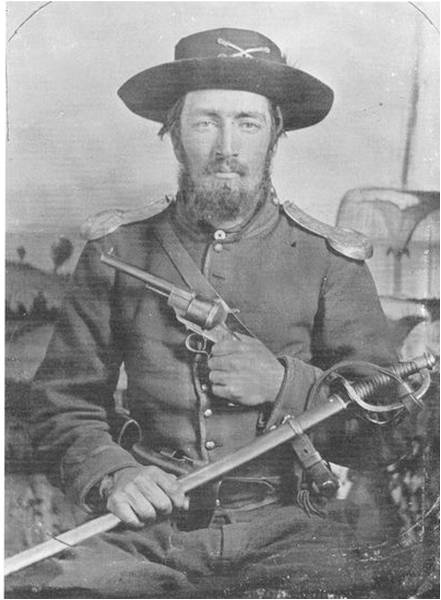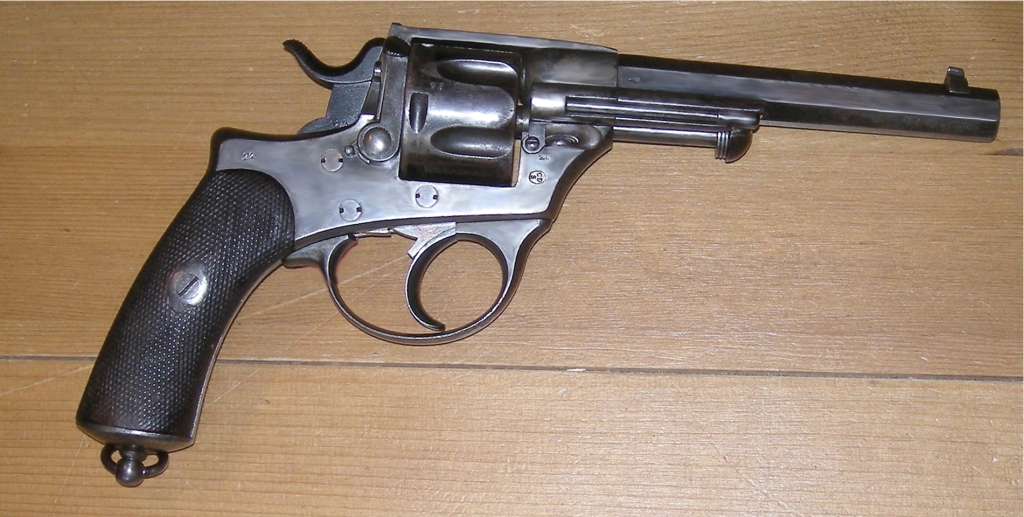|
12 Mm Lefaucheux
The 12mm Lefaucheux is a metallic center-fire cartridge. It was originally created as a rimless pinfire cartridge using black powder employed by the French navy on the Lefaucheux M1858 revolver. Later adapted for center-fire by the French Army in 1873 for use on the MAS 1873 revolver. Overview Originally, the 12 mm, was a classic Lefaucheux cartridge, with a side pin from its introduction in 1858 until 1873, when it was adapted and became a rimmed center-fire cartridge for use in the MAS revolver 1873-1874 then used by the French Army. Features These are the characteristics of the '12 mm Lefaucheux' cartridge: * Brass case * Caliber: 12mm * Ammo: 12 X 17 * Bullet diameter: 11.30 - 11.40 mm (.444" - .448") * Neck diameter: 11.80 - 11.85 mm (.464" - .466) * Base diameter: 11.90 - 11.92 mm (.468" - .469") * Rim diameter: 12.64 - 12.66 mm (.497" - .498") * Rim thickness: 0.9 - 1.0 mm (.035" - .039") * Case length: 19.90 - 20.00 mm (.783" - .787") * Overall length: 30.77 - 30.80 mm ... [...More Info...] [...Related Items...] OR: [Wikipedia] [Google] [Baidu] |
Center-fire Cartridge
Two rounds of .357 Magnum, a centerfire cartridge; notice the circular primer in the center A centerfire cartridge is a firearm metallic cartridge whose primer is located at the center of the base of its casing (i.e. "case head"). Unlike rimfire cartridges, the centerfire primer is typically a separate component seated into a recessed cavity (known as the ''primer pocket'') in the case head and is replaceable by reloading. Centerfire cartridges have supplanted the rimfire variety in all but the smallest cartridge sizes. The majority of today's handguns, rifles, and shotguns use centerfire ammunition, with the exception of a few .17 caliber, .20 caliber, and .22 caliber handgun and rifle cartridges, small-bore shotgun shells (intended for pest control), and a handful of antique (and mostly obsolete) cartridges. History An early form of centerfire ammunition, without a percussion cap, was invented between 1808 and 1812 by Jean Samuel Pauly. This was also the first fully ... [...More Info...] [...Related Items...] OR: [Wikipedia] [Google] [Baidu] |
Pinfire Cartridge
A pinfire cartridge is an obsolete type of metallic firearm cartridge in which the priming compound is ignited by striking a small pin which protrudes radially from just above the base of the cartridge. Invented by Frenchman Casimir Lefaucheux in the 1830s but not patented until 1835, it was one of the earliest practical designs of a metallic cartridge. Its history is closely associated with the development of the breechloader which replaced muzzle-loading weapons. History The Swiss gun maker Samuel Joannes Pauly patented the first breechloading cartridge in 1812. This was for use in a shotgun with fixed barrels which was loaded by lifting a breech block on the top. French gun maker Henri Roux attempted to improve this cartridge in the 1820s but a constantly primed cartridge was felt by many to be too dangerous and many breechloading guns reverted to using an unprimed cartridge. This was fired by a separate percussion cap which was used on the still dominant muzzle-loading guns ... [...More Info...] [...Related Items...] OR: [Wikipedia] [Google] [Baidu] |
Lefaucheux M1858
The Lefaucheux M1858 was a French military revolver developed for the navy, chambered for the 12 mm pinfire cartridge, and based on a design by Casimir Lefaucheux and his son, Eugene (also a gun designer). The 1854 model was the first metallic-cartridge revolver adopted by a national government; the 1858 was the first variant fielded.Kinard, Jeff. ''Pistols: An illustrated history of their impact''. ABC-CLIO, 2004. ,. p. 110 It was first issued in 1858 by the French Navy (as either the Lefaucheux de Marine mle 1858 or simply M1858), and though never issued by the French Army, it was used in limited numbers by the French Cavalry during their 1862 deployment to Mexico. The 1858 was later upgraded in the late 1860s as the Lefaucheux de Marine 1870. It was accepted by the French Navy, but only 150 copies were delivered by 1872. Models of the 1858 were also purchased by Spain, Sweden, Italy, Russia, and Norway. Most were produced either at the state arsenal Manufacture d'armes d ... [...More Info...] [...Related Items...] OR: [Wikipedia] [Google] [Baidu] |
MAS 1873 Revolver
The service revolver model 1873 Chamelot-Delvigne was the first double-action revolver used by the French Army. It was produced by Manufacture d'armes de Saint-Étienne from 1873 to 1887 in about 337,000 copies. Although replaced by the Modele 1892 revolver, it was nevertheless widely used during the First World War and issued to reserve units in 1940. The French Resistance made widespread use of it during the German occupation. The model 1874, of which 35,000 were made, was an officer's version. It differs from the model 1873 by having a lighter structure and a darker finish. Many copies for civilian sale were made in France and Belgium. Both the 1873 and the 1874 use an 11mm cartridge which proved to have insufficient velocity. The weapons themselves were very reliable and resistant to damage. A Navy version was also produced. A more powerful cartridge was produced for this version, but production ceased and they turned to the regular ammunition when the stocks were depleted. ... [...More Info...] [...Related Items...] OR: [Wikipedia] [Google] [Baidu] |
12×17mm Lefaucheux Metallic
1 (one, unit, unity) is a number representing a single or the only entity. 1 is also a numerical digit and represents a single unit of counting or measurement. For example, a line segment of ''unit length'' is a line segment of length 1. In conventions of sign where zero is considered neither positive nor negative, 1 is the first and smallest positive integer. It is also sometimes considered the first of the infinite sequence of natural numbers, followed by 2, although by other definitions 1 is the second natural number, following 0. The fundamental mathematical property of 1 is to be a multiplicative identity, meaning that any number multiplied by 1 equals the same number. Most if not all properties of 1 can be deduced from this. In advanced mathematics, a multiplicative identity is often denoted 1, even if it is not a number. 1 is by convention not considered a prime number; this was not universally accepted until the mid-20th century. Additionally, 1 is th ... [...More Info...] [...Related Items...] OR: [Wikipedia] [Google] [Baidu] |
Headstamp
A headstamp is the markings on the bottom of a cartridge case designed for a firearm. It usually tells who manufactured the case. If it is a civilian case it often also tells the caliber: if it is military, the year of manufacture is often added. The headstamp is punched into the base of the cartridge during manufacture. A resource for identifying where the ammunition originated can be found aCartridge Collectors Australia * BB ''Bertram Bullet Co. Pty. Ltd.'' (1986–present) – Seymour, Melbourne, Victoria. Bruce Bertram bought Super Cartridge Co.'s machinery and moved it to Seymour, where he began manufacturing brass cases for handloaders. The "BB" is at 12 o'clock and small kangaroos are positioned counter-clockwise at 3 o'clock and 9 o'clock. Brass is sold in lots of 20-case cartons and can be made to customer's specifications with personalized headstamps. * ICI-ANZ ''Imperial Chemical Industries – Australia / New Zealand'' (1940s – 1980s) – Deer Park, Melb ... [...More Info...] [...Related Items...] OR: [Wikipedia] [Google] [Baidu] |
12×17mm Lefaucheux Fixed Dimensions
1 (one, unit, unity) is a number representing a single or the only entity. 1 is also a numerical digit and represents a single unit of counting or measurement. For example, a line segment of ''unit length'' is a line segment of length 1. In conventions of sign where zero is considered neither positive nor negative, 1 is the first and smallest positive integer. It is also sometimes considered the first of the infinite sequence of natural numbers, followed by 2, although by other definitions 1 is the second natural number, following 0. The fundamental mathematical property of 1 is to be a multiplicative identity, meaning that any number multiplied by 1 equals the same number. Most if not all properties of 1 can be deduced from this. In advanced mathematics, a multiplicative identity is often denoted 1, even if it is not a number. 1 is by convention not considered a prime number; this was not universally accepted until the mid-20th century. Additionally, 1 is th ... [...More Info...] [...Related Items...] OR: [Wikipedia] [Google] [Baidu] |
12 Mm Caliber
This is a list of firearm cartridges which have bullets in the to caliber range. *''Length'' refers to the cartridge case length. *''OAL'' refers to the overall length of the cartridge. *''Bullet'' refers to the diameter of the bullet. Some measurements are in millimetres, while others are measured in inches. Self-loading pistol cartridges Revolver cartridges Rifle cartridges ''Note: The .50 Sharps, Winchester and US Government cartridges are actually of 13 mm caliber'' See also *.50 caliber handguns A .50 caliber handgun is a handgun firing a bullet measuring approximately in diameter. Historically, many black powder pistols fired bullets with diameters well above a half inch. However, following the development of smokeless powder, the focus ... References {{Firearm cartridge calibers Pistol and rifle cartridges ... [...More Info...] [...Related Items...] OR: [Wikipedia] [Google] [Baidu] |
List Of Handgun Cartridges
List of handgun cartridges, approximately in order of increasing caliber. Table of handgun cartridges {, class="wikitable sortable" style="text-align:left" , - ! Cartridge name , , Bulletdiameter , , Caselength , , Cartridgelength , , Type , , class="unsortable", Source , - , 2.34mm rimfire (for Swiss mini gun), , , , , , - , , Rimmed, rimfire , , {{cite web, , - , 2.7mm Kolibri (2mm Kolibri, 2.7×9mm), , {{convert, .107, in, mm, abbr=on , , {{convert, .370, in, mm, abbr=on , , {{convert, .430, in, mm, abbr=on , , Rimless , , {{sfn, Barnes , 1997, p=274 , - , 3 mm Kolibri, , {{convert, .120, in, mm, abbr=on , , {{convert, .320, in, mm, abbr=on , , {{convert, .430, in, mm, abbr=on , , Rimless , , {{sfn, Barnes , 1997, p=274 , - , 4.25 mm Liliput (4.25 mm Erika), , {{convert, .167, in, mm, abbr=on , , {{convert, .410, in, mm, abbr=on , , {{convert, .560, in, mm, abbr=on , , Rimless , , {{sfn, Barnes , 1997, p=274 , - , .17 Hornady Mach 2 (.17 HM ... [...More Info...] [...Related Items...] OR: [Wikipedia] [Google] [Baidu] |
Pistol And Rifle Cartridges
A pistol is a handgun, more specifically one with the chamber integral to its gun barrel, though in common usage the two terms are often used interchangeably. The English word was introduced in , when early handguns were produced in Europe, and is derived from the Middle French ''pistolet'' (), meaning a small gun or knife. In colloquial usage, the word "pistol" is often used to describe any type of handgun, inclusive of revolvers (which have a single barrel and a separate cylinder housing multiple chambers) and the pocket-sized derringers (which are often multi-barrelled). The most common type of pistol used in the contemporary era is the semi-automatic pistol, while the older single-shot and lever action, manual repeating pistols are now rarely seen and used primarily for nostalgic hunting and historical reenactment, and the fully automatic machine pistols are uncommon in civilian usage due to generally poor recoil-controllability and strict gun laws, laws and regulations ... [...More Info...] [...Related Items...] OR: [Wikipedia] [Google] [Baidu] |





